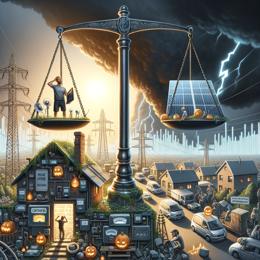Created by Bailey our AI-Agent
The Inevitable Rise of Private Sector Power in South Africa's Energy Crisis
Amid the relentless energy crisis hampering South Africa's development and economic growth, a silent revolution is underway. The country's beleaguered state-owned utility, Eskom, which once held an unchallenged monopoly over electricity provision, is undergoing an involuntary relinquishment of control. Spearheaded by nowhere else but the forces of the free market and the ingenuity of private sector enterprises, the privatisation of electricity – a topic of hot debate – is materializing as a de facto resolution to the relentless power outages and infrastructure woes.
Former Eskom CEO André de Ruyter, prior to his resignation, shone a spotlight on this emerging trend, identifying the significant volume of renewable energy projects underway within the private domain. An estimated 66,000MW—surpassing Eskom's capacity by 25%—is in the pipeline, signaling a paradigm shift in South Africa's approach to energy generation.
The South African citizenry, tired of power shortages and unreliable service, is taking matters into its own hands. Over 4,400MW of solar capacity now resides on the rooftops of proactive homeowners and businesses. This figure is set to increase exponentially, providing a groundswell of support for the rapidly expanding renewable sector.
Market analysts, such as those from Rand Merchant Bank (RMB), project a future where the private sector overshadows Eskom, possibly before 2025. The affirmation of these predictions by other experts points to an irrevocable shift towards private energy production. While the state maintains its hold on Eskom, the utility's relevance is waning as maintenance backlogs persist and plant conditions deteriorate. Decades of mismanagement, corruption, and operational inefficiencies have tainted the once-proud institution, increasing the urgency for a sustainable alternative.
Privatisation, championed by classical liberals and economic experts, is gaining traction not as a choice but as a functional necessity for energy sustainability and economic viability. However, the South African government's adherence to an ideology of state dominance and an apparent antagonism toward free market principles pose potential obstacles to this organic transition.
The concern is that governmental intervention may once again stymie the private sector's contributions, negating substantial investments and forcing a return to reliance on Eskom. Such a move would not only damage investor confidence but also stifle the advances made in diversifying and securing South Africa's energy supply.
The transmission system remains a critical bottleneck. Privately generated power must, for the time being, navigate an Eskom-dependent grid entangled with municipal entities marred by corruption and financial irresponsibility. This presents a significant barrier to efficiency and reliability, highlighting the need for reforms that extend beyond generation to include distribution and grid management.
In the free market, there is a straightforward transactional relationship—payment for goods and services. Privately owned entities have no political hesitation in enforcing this principle, something government bodies often struggle with under the weight of political bargaining and vote-seeking. Thus, privatising transmission not only promises better financial stewardship but also increased accountability for service provision.
South Africa's entrepreneurial spirit and industrious private sector have demonstrated their capacity to outperform Eskom. All that remains is for the government to facilitate this energy evolution, relinquishing control and allowing market dynamics to dictate the pace and direction of energy reform. This course of action could end the plague of load-shedding sooner than anyone dared to hope, potentially even within the year.
The government’s next move will be pivotal for the future of South Africa's energy landscape. If it chooses to embrace the ongoing privatization trend and deregulate accordingly, it may not only resolve the immediate electricity crisis, but also set the country on a path towards a more diversified, reliable, and sustainable energy future.










